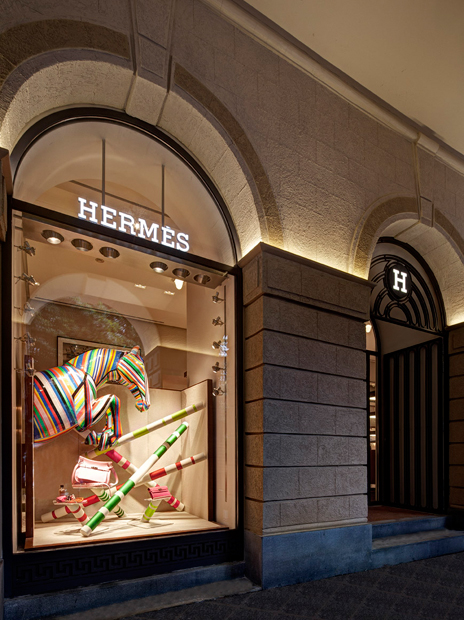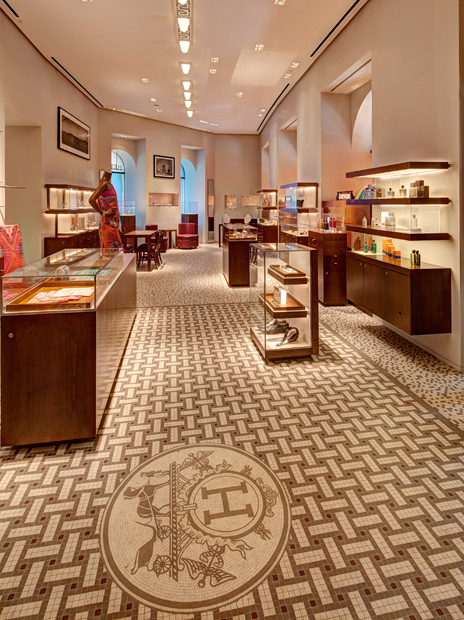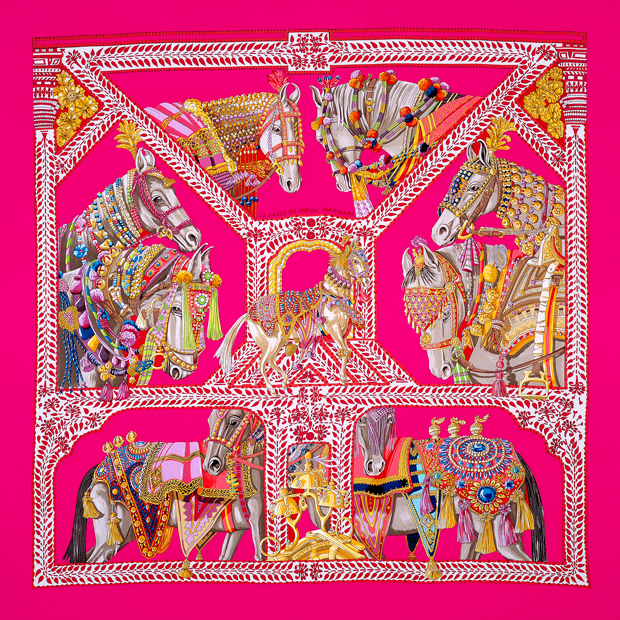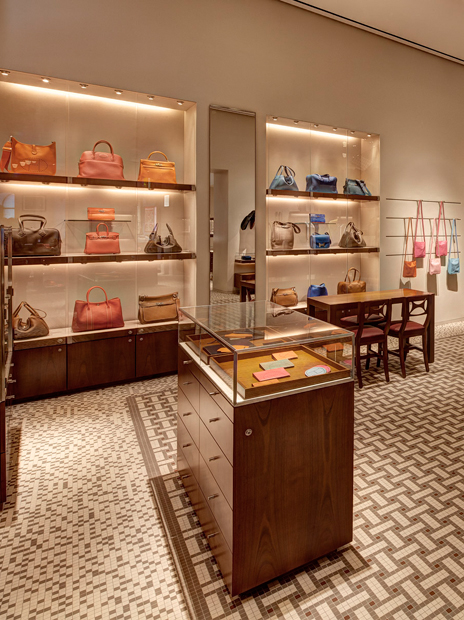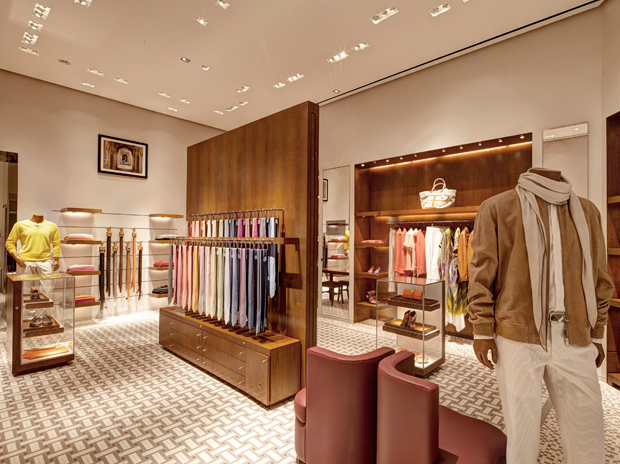
There is a lariat of velvet rope, skeins of ancient gold and the softest leather wrapped around the globe and reaching across history. These strands tell the story of one of the dominant landmarks on the luxury landscape, that of Hermès. Luxuriantly they bridle the power and raw beauty of man’s extraordinary equine companion and tie together two noble nations, France and India, which is where the latest instalment in this tale takes place.
Where once the horse was man’s beast of burden - powering transport, agriculture, exploration and warfare, it has been left bereft of use by the advancing march of technology in the modern world.
Nowadays the horse is for most a luxurious adornment to lifestyles featuring such lavish luxuries as polo, the sport of kings, which originated in Persia over two thousand years ago and arrived in Europe via the fields of Manipur, India. It is now one of the global emblems of elite lifestyle, a combination of extraordinary wealth and ancient tradition that gives contemporary princes the chance to practice the chivalric art of mounted combat once more. This great beast is key to the Hermès story.
From humble Parisian beginnings in a harness and saddle workshop in 1837 on rue Basse du Rempart, Thierry Hermès’ developed a reputation for rending beauty from the equestrian necessities of the day. By the time of the Exposition Universelle, this master craftsman had been awarded the First Class Medal, and had already set in motion one of the great artisanal and design dynasties of modern times.
On his death in 1878 Thierry was succeeded by his son, Charles-Emile, who transferred activities to a more expansive store and workshops at 24 Faubourg Saint-Honoré. Working alongside his sons Adolphe and Emile-Maurice, Charles-Emile transformed Hermès into the saddler of choice for the world’s great aristocracies - from England to Siam and beyond - and the uppermost echelons of post-colonial Latin American society.
The younger of the brothers, Emile-Maurice, oversaw perhaps the greatest period of change and diversification in the company’s history. He had already innovatively expanded the Hermès repertoire with his brother during their period of joint control of the company under its guise as Hermès Frères (1902-1919), by introducing bespoke saddle accessory the Haut à courroies bag.
With the advent of the automobile, Emile knew the company had to dedicate itself to innovation and transformed it into a provider of deluxe “saddlestitched” leatherwork - bags, luggage, sport and driving accessories - for the travel demands of their international elite clientele. He did not stop there, however, producing clothing, silk scarves, belts, gloves watches and jewellery expertly crafted from the finest materials to the same exacting standards that had made his father famous.
From this point, Hermès exploded into a luxury company of truly multinational renown, with Emile opening a string of plush resort boutiques and moving gracefully into fashion design, producing hit beach and skiwear collections. Under Emile’s stewardship in the 1930s Hermès introduced the some of the products that have gone on to become enduring classics on the international luxury market.
The exquisite symmetry of the of the Sac à dépêches, a handbag wrought in the finest leather, was an instant smash. The pared down beauty was so timelessly stylish that it later adopted the moniker the “Kelly bag” in homage to the Princess of Monaco, Grace Kelly; a star of stratospheric proportions whose beauty and ultra-sophisticated simplicity chimed perfectly with the bag she wore so dedicatedly. In 1937 Hermès, inspired once more by its equestrian roots, began to work in silk, a material previously used for jockey jerseys, producing a collection of vivid printed scarves which once more went on to become sought after luxury trademarks.
Emile was succeeded first by his son-in-law in Robert Dumas, who expanded the company’s horizons further into perfumery and haute couture, and personally oversaw the development of the company’s silk design team until it became an unparalleled exponent of the art.
Robert was himself succeeded by his son Jean-Louis in 1978, who faithfully continued the family traditions, following the footsteps of his grandfather and designing the famous Birkin bag in 1984 in honour of great contemporary actress and Parisian icon Jane Birkin. As well, he created La Montre Hermès SA, the company’s prestigious Swiss watchmaker, and bought the exclusive boot-maker John Lobb, top-tier crystal-maker Saint-Louis and the elite silversmith Puiforcat.
Since then, the company has gone from strength to strength, now one of the last true fashion dynasties and a giant standing astride the pinnacle of the global luxury market. It has thrillingly combined truly groundbreaking design, and an innovative and visionary business approach that has practically invented and reinvented its own market. All the while, it is venerated for using age-old handcrafts practiced by often generations of the same families of highly skilled craftspeople working with only the finest materials.
It is this philosophy of painstaking attention to detail that marks out each individual Hermès product in the brand’s sixteen product families - ranging from luggage to tableware - as a unique cultural and aesthetic artefact of rare beauty and great value. The most famous Hermès classics, such as its signature silk scarves and the Kelly and Birkin bags, are cultural and commercial phenomena, attracting almost as much attention as the movie stars that wear them on our front pages.
It is in examining this creative legacy that we see an equally remarkable and vitally important aspect to the Hermès identity, namely its relationship with India. For many years India has had a powerful influence on the company - especially on Jean-Louis Dumas who travelled across India in an old Citroen in his youth - providing a constant source of exquisite materials, traditionally skilled artisans, and above all inspiring the company’s designers with the extraordinary richness and colour of its exuberantly sacred culture.
And so it is to modern India, and Mumbai, that the Hermès carriage makes its next stop. One of the world’s great cities, it represents the epic struggles of its colonial past through its staggering collection of luxurious Gothic Revival and Art Decó architecture, the extravagant present as the “Bollywood” home of India’s extraordinary movie industry, and the future as the financial centre of this newly exploding global economic powerhouse.
This summer, Hermès opened its first Mumbai store in the Horniman Circle Square, one of the city’s most prestigious retail locations. The building, designed by Paris architects RDAI - founded by Rena Dumas in 1972 - and the first stand alone luxury European brand outlet on the street in India, is closeted intimately by a series of arches. Its entrance sits below a classic Hermès Greek meander frieze pattern and gives way to a stunning mosaic floor featuring the trademark Hermès ex-libris design. An impressive stone staircase and the glass elevator shaft it wraps sinuously around provide an impressive centrepiece to this beautiful space and connect its two spacious retail floors.
The company has constructed a dedicated gallery area for special exhibitions in the adjacent building. As a tribute to its gracious host city and in support of the Asiatic Society of Mumbai, Hermès has produced an exclusive silk scarf La Danse du Cheval Marwari, featuring the world famous Marwari horse as a motif for the company’s intimate links with India.
Of course it is with the horse that the Hermès story began, and it is this aristocratic bond with the prancing power and immutable grace of this great creature with which the company marks its extraordinary products.
Introduced in the 1950s, the “the Duc carriage with horse” logo is a constant reminder of the exaltedly equestrian nature of Hermès’ origins, but humbly belies the breathtaking force of its innovation for over a century and a half.
However, all those with the means or the culture sufficient to know the calibre of what lies within the truly iconic Hermès orange presentation boxes knows that it is a unique fusion of both daring modernity and epic tradition that awaits.
- Benjamin Stewart
Hermès Mumbai
Address: 15A Horniman Circle
Mumbai, 400001
Tel: 22 63 00 93
Website: www.hermes.com
Product Families: Bags and luggage, diaries and small leather goods,
Saddles, silk, women´s ready-to-wear, men´s ready-to-wear, jewellery,
Watches, belts, gloves, footwear, hats, enamel and fantasy jewellery,
Art of living, tableware, perfume, Hermès Intérieur & Design
Where once the horse was man’s beast of burden - powering transport, agriculture, exploration and warfare, it has been left bereft of use by the advancing march of technology in the modern world.
Nowadays the horse is for most a luxurious adornment to lifestyles featuring such lavish luxuries as polo, the sport of kings, which originated in Persia over two thousand years ago and arrived in Europe via the fields of Manipur, India. It is now one of the global emblems of elite lifestyle, a combination of extraordinary wealth and ancient tradition that gives contemporary princes the chance to practice the chivalric art of mounted combat once more. This great beast is key to the Hermès story.
From humble Parisian beginnings in a harness and saddle workshop in 1837 on rue Basse du Rempart, Thierry Hermès’ developed a reputation for rending beauty from the equestrian necessities of the day. By the time of the Exposition Universelle, this master craftsman had been awarded the First Class Medal, and had already set in motion one of the great artisanal and design dynasties of modern times.
On his death in 1878 Thierry was succeeded by his son, Charles-Emile, who transferred activities to a more expansive store and workshops at 24 Faubourg Saint-Honoré. Working alongside his sons Adolphe and Emile-Maurice, Charles-Emile transformed Hermès into the saddler of choice for the world’s great aristocracies - from England to Siam and beyond - and the uppermost echelons of post-colonial Latin American society.
The younger of the brothers, Emile-Maurice, oversaw perhaps the greatest period of change and diversification in the company’s history. He had already innovatively expanded the Hermès repertoire with his brother during their period of joint control of the company under its guise as Hermès Frères (1902-1919), by introducing bespoke saddle accessory the Haut à courroies bag.
With the advent of the automobile, Emile knew the company had to dedicate itself to innovation and transformed it into a provider of deluxe “saddlestitched” leatherwork - bags, luggage, sport and driving accessories - for the travel demands of their international elite clientele. He did not stop there, however, producing clothing, silk scarves, belts, gloves watches and jewellery expertly crafted from the finest materials to the same exacting standards that had made his father famous.
From this point, Hermès exploded into a luxury company of truly multinational renown, with Emile opening a string of plush resort boutiques and moving gracefully into fashion design, producing hit beach and skiwear collections. Under Emile’s stewardship in the 1930s Hermès introduced the some of the products that have gone on to become enduring classics on the international luxury market.
The exquisite symmetry of the of the Sac à dépêches, a handbag wrought in the finest leather, was an instant smash. The pared down beauty was so timelessly stylish that it later adopted the moniker the “Kelly bag” in homage to the Princess of Monaco, Grace Kelly; a star of stratospheric proportions whose beauty and ultra-sophisticated simplicity chimed perfectly with the bag she wore so dedicatedly. In 1937 Hermès, inspired once more by its equestrian roots, began to work in silk, a material previously used for jockey jerseys, producing a collection of vivid printed scarves which once more went on to become sought after luxury trademarks.
Emile was succeeded first by his son-in-law in Robert Dumas, who expanded the company’s horizons further into perfumery and haute couture, and personally oversaw the development of the company’s silk design team until it became an unparalleled exponent of the art.
Robert was himself succeeded by his son Jean-Louis in 1978, who faithfully continued the family traditions, following the footsteps of his grandfather and designing the famous Birkin bag in 1984 in honour of great contemporary actress and Parisian icon Jane Birkin. As well, he created La Montre Hermès SA, the company’s prestigious Swiss watchmaker, and bought the exclusive boot-maker John Lobb, top-tier crystal-maker Saint-Louis and the elite silversmith Puiforcat.
Since then, the company has gone from strength to strength, now one of the last true fashion dynasties and a giant standing astride the pinnacle of the global luxury market. It has thrillingly combined truly groundbreaking design, and an innovative and visionary business approach that has practically invented and reinvented its own market. All the while, it is venerated for using age-old handcrafts practiced by often generations of the same families of highly skilled craftspeople working with only the finest materials.
It is this philosophy of painstaking attention to detail that marks out each individual Hermès product in the brand’s sixteen product families - ranging from luggage to tableware - as a unique cultural and aesthetic artefact of rare beauty and great value. The most famous Hermès classics, such as its signature silk scarves and the Kelly and Birkin bags, are cultural and commercial phenomena, attracting almost as much attention as the movie stars that wear them on our front pages.
It is in examining this creative legacy that we see an equally remarkable and vitally important aspect to the Hermès identity, namely its relationship with India. For many years India has had a powerful influence on the company - especially on Jean-Louis Dumas who travelled across India in an old Citroen in his youth - providing a constant source of exquisite materials, traditionally skilled artisans, and above all inspiring the company’s designers with the extraordinary richness and colour of its exuberantly sacred culture.
And so it is to modern India, and Mumbai, that the Hermès carriage makes its next stop. One of the world’s great cities, it represents the epic struggles of its colonial past through its staggering collection of luxurious Gothic Revival and Art Decó architecture, the extravagant present as the “Bollywood” home of India’s extraordinary movie industry, and the future as the financial centre of this newly exploding global economic powerhouse.
This summer, Hermès opened its first Mumbai store in the Horniman Circle Square, one of the city’s most prestigious retail locations. The building, designed by Paris architects RDAI - founded by Rena Dumas in 1972 - and the first stand alone luxury European brand outlet on the street in India, is closeted intimately by a series of arches. Its entrance sits below a classic Hermès Greek meander frieze pattern and gives way to a stunning mosaic floor featuring the trademark Hermès ex-libris design. An impressive stone staircase and the glass elevator shaft it wraps sinuously around provide an impressive centrepiece to this beautiful space and connect its two spacious retail floors.
The company has constructed a dedicated gallery area for special exhibitions in the adjacent building. As a tribute to its gracious host city and in support of the Asiatic Society of Mumbai, Hermès has produced an exclusive silk scarf La Danse du Cheval Marwari, featuring the world famous Marwari horse as a motif for the company’s intimate links with India.
Of course it is with the horse that the Hermès story began, and it is this aristocratic bond with the prancing power and immutable grace of this great creature with which the company marks its extraordinary products.
Introduced in the 1950s, the “the Duc carriage with horse” logo is a constant reminder of the exaltedly equestrian nature of Hermès’ origins, but humbly belies the breathtaking force of its innovation for over a century and a half.
However, all those with the means or the culture sufficient to know the calibre of what lies within the truly iconic Hermès orange presentation boxes knows that it is a unique fusion of both daring modernity and epic tradition that awaits.
- Benjamin Stewart
Hermès Mumbai
Address: 15A Horniman Circle
Mumbai, 400001
Tel: 22 63 00 93
Website: www.hermes.com
Product Families: Bags and luggage, diaries and small leather goods,
Saddles, silk, women´s ready-to-wear, men´s ready-to-wear, jewellery,
Watches, belts, gloves, footwear, hats, enamel and fantasy jewellery,
Art of living, tableware, perfume, Hermès Intérieur & Design
Hermès Mumbai




